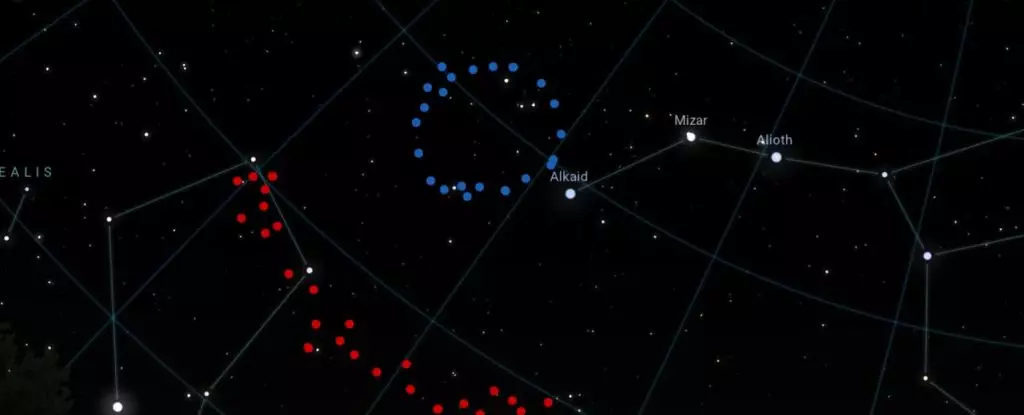In the vastness of the Universe, a perplexing structure has astounded astronomers and challenged our understanding of cosmic evolution. A colossal ring of galaxies, spanning approximately 1.3 billion light-years in diameter, has been discovered in the distant cosmos after traveling 6.9 billion light-years to reach us. Dubbed the “Big Ring,” this puzzling structure defies any known formation mechanism or established model of cosmology. The revelation, unveiled by astronomer Alexia Lopez and her team from the University of Central Lancashire, has left scientists questioning whether the standard model of cosmology needs revision. This extraordinary finding was presented at the 243rd meeting of the American Astronomical Society, captivating the scientific community and igniting a quest for answers.
A Ring Like No Other
The enigmatic Big Ring bears no resemblance to any familiar cosmic structure. It raises fundamental questions about the nature of the Universe and could represent a revolutionary breakthrough in our understanding of cosmology. Interestingly, this is not the first mind-boggling discovery made by Lopez and her team. Their previous find, known as the “Giant Arc,” is located in the same region of the sky and shares the same distance from us. The mysterious Giant Arc had already confounded astronomers when it was announced in 2021. The discovery of the Big Ring has only deepened the cosmic puzzle, leaving scientists grappling with its implications. Lopez reflects, “Neither of these two ultra-large structures is easy to explain in our current understanding of the universe. And their ultra-large sizes, distinctive shapes, and cosmological proximity must surely be telling us something important – but what exactly?”
Initial investigations suggest a possible connection between the enigmatic Big Ring and a phenomenon called Baryon Acoustic Oscillation (BAO). BAOs are vast, spherical arrangements of galaxies scattered throughout space. They represent remnants of acoustic waves that propagated during the early stages of the Universe, freezing in place as space expanded and acoustic waves could no longer travel. However, the Big Ring does not fit the BAO profile. Unlike the fixed size of approximately 1 billion light-years that characterizes BAOs, the Big Ring assumes a distinctive coiled shape, resembling a corkscrew aligned in a manner that produces a ring-like appearance. This stark deviation from the expected structure prompts the monumental question: What exactly is this perplexing formation? Furthermore, this finding challenges the Cosmological Principle, which posits that any given area of space should appear relatively uniform in all directions. The presence of such an irregular structure raises eyebrows and calls for a reevaluation of our existing knowledge.
The Conundrum of Size
The size of the Big Ring introduces another layer of perplexity to this cosmic mystery. According to current theoretical calculations, structures of this magnitude should not exist. Cosmologists have determined the upper limit for structure size to be around 1.2 billion light-years. Astonishingly, the Giant Arc, which is nearly three times larger, and the Big Ring, with its circumference comparable to the Giant Arc’s length, defy these limits. The sheer scale of these structures challenges our understanding of the Universe’s organization and casts doubt on the predictive power of current cosmological models. The implications of these unprecedented findings amplify the necessity for reevaluation and inspire new avenues of exploration.
The discovery of the Big Ring carries profound consequences for the field of cosmology, the discipline devoted to unraveling the mysteries of the Universe’s evolution. While the current model aligns most closely with our observations, it struggles to account for certain features that challenge its framework. Consequently, alternative models have emerged in an attempt to address these discrepancies. One notable proposal is Roger Penrose’s conformal cyclic cosmology, which posits that the Universe undergoes an infinite cycle of expansion and contraction, punctuated by Big Bang events. This cyclic model predicts the existence of ring structures. However, it is important to note that conformal cyclic cosmology faces its own significant challenges.
A Glimmer of Possibility: Cosmic Strings
Another plausible explanation for the enigmatic structures lies in the realm of cosmic strings, topological defects woven into the fabric of space-time. These cosmic wrinkles, believed to be as thin as a proton, emerged during the early stages of the Universe as space-time expanded and became locked in place. Although physical evidence of cosmic strings remains scarce, theoretical foundations present compelling support. Currently, the scientific community lacks certainty regarding the true nature of the Big Ring and the Giant Arc. It is conceivable that these formations are chance arrangements of galaxies adrift in the cosmos. However, given the low probability of such fortuitous occurrences, the search for more celestial configurations resembling the Big Ring and the Giant Arc becomes imperative. Conceivably, these hidden structures scattered throughout the Universe may hold the key to unlocking this cosmic puzzle.
The astounding discoveries of the Big Ring and the Giant Arc have ignited a fire in the hearts of scientists and stargazers alike. These colossal structures, positioned as cosmological neighbors, defy the limits of our current understanding and beckon further exploration. Current cosmological theories have not envisioned structures of this scale within our observable Universe. The existence of two immense formations located in such close proximity instills a sense of awe and curiosity in researchers, driving them to push the frontiers of knowledge ever further. These mind-boggling revelations invite cosmic detectives to journey into the depths of the Universe, seeking out the hidden truths that lie beyond our comprehension.
The annals of science have been forever altered by the unveiling of the enigmatic Big Ring and the Giant Arc. These gargantuan structures, pulsating with cosmic secrets, demand that we question the fabric of our current understanding of the Universe. The scientific community’s pursuit of truth and the drive to decipher these cosmic enigmas will propel us towards new frontiers of knowledge, revolutionizing our perception of the cosmos and perhaps ushering in a new era of cosmological understanding. The Big Ring and the Giant Arc serve as poignant reminders of the boundless wonders that await our exploration in the distant reaches of the Universe.


Leave a Reply